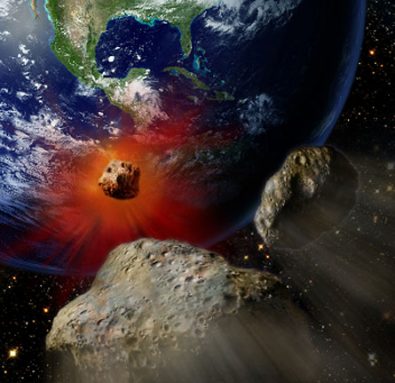Meteorites may have sparked life on Earth
A collision of extraterrestrial objects and Earth’s ancient oceans could have produced raw materials for life
 |
|
Extraterrestrial objects colliding with Earth’s ancient oceans may have sparked the molecules necessary for life.
|
| duuuna / iStockphoto |
Thoughts of meteors hurtling toward Earth usually generate visions of mass extinctions. But some recent studies paint a new picture: Large rocks hurtling in from space may have actually helped spark life on Earth.
Nobody would call early Earth a friendly place. Billions of years ago, it started as a red-hot sea of molten rock. But then the surface cooled enough for oceans to form. During that era meteorites slammed into Earth about 1,000 times more frequently than they do today.
These conditions might not seem welcoming to life. Still, scientists say they may have been just the recipe needed to jump-start a few life-producing chemical reactions.
Geochemist Yoshihiro Furukawa at Tohoku University in Sendai, Japan had a theory about how this could happen. When large extraterrestrial objects crashed into Earth’s ancient oceans, they produced enormous heat and pressure that caused objects to vaporize, or turn into gas. Furukawa thought such powerful events may have triggered chemical reactions that generated organic molecules from basic ingredients. To test this theory, he and his colleagues designed a study.
To simulate the power of a collision between an extraterrestrial object and an ancient ocean, the scientists used a propellant gun. It keeps objects under high pressure. When that pressure is released, the gun’s contents shoot out at high speeds.
To get the right recipe for such a collision, the scientists combined ingredients commonly found in meteorites and in Earth’s ancient oceans and atmosphere. The scientists started with water, ammonia and nitrogen, all present in early Earth. Into this they mixed elements found in the most common type of meteorites — carbon, iron and nickel.
The team then placed the whole mix inside stainless steel canisters, then used the gun to fire them at solid targets. The canisters reached speeds of more than 1 kilometer per second.
The researchers hoped to see how a high-temperature, high-velocity impact affected various mixtures of the ingredients. When canisters were fired at the target, the temperatures inside became scorching. They briefly rose to about 4,700 degrees Celsius (nearly 8500 degrees Fahrenheit). The pressure generated inside the canisters by the impact was about 60,000 times that of ordinary atmospheric pressure at sea level.
Afterward, the scientists analyzed the contents of these drums. Inside them was a variety of organic molecules. These included fatty acids, such as those found in cell membranes. The team also found a variety of amines, which are used to create amino acids, the building blocks of life. One test even generated a type of amino acid, called glycine, which is commonly found in proteins.
The study shows how conditions on the Earth 4 billion years ago may have spurred the synthesis, or creation, of amino acid. Scientists say the study sheds new light on how and when organic molecules appeared on the young Earth.
Previous studies had hinted that lightning striking Earth’s ancient atmosphere could have generated the organic molecules needed for life as well. And such studies also have suggested that the chemical reactions around deep-sea hydrothermal vents — where water heated inside the Earth is expelled from cracks in the sea floor — could have produced these molecules.







